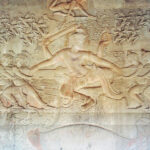
Significantly Kurmi (Tortoise) Awatar (Avatar) was one of the ten incarnations of Bisnu (Visnu). Once upon a mythical time, according to the Hindu tradition, gods in heaven decided to churn the cosmic ocean to extract divine blessings hidden in the abyss. They decided to employ Mount Kailash as the churning paddle and Basuki Nag, the Serpent god as the rope and god Bisnu (Visnu) volunteered to hold Mount Kailash on his back turning himself into a tortoise. They marshalled all the gods of heaven but were unable to muster enough head counts for the enterprise. Therefore, they decided to invite the devils for help with a promise that they would share equally whatever boons they may obtain.
One of the several boons which the cosmic ocean yielded was Kamadhenu cow, which would grant any gift a seeker may desire. It also yielded so potent poison whose even a single drop could reduce the entire universe into ashes (its significance is separately explained elsewhere). Finally came out the amrit (or amrut) which would give any partaker immortal life and this the gods had no intention of sharing with the demons. So, Bisnu (Visnu) took the form of a beautiful dancing woman and having made the gods and demons to sit in two rows, began to feed one spoon at a time as she danced.
Sensing everything was not right a demon cleverly disguised as a god sat himself amongst the gods and managed to take a sip of amrit (or amrut), the immortal life giving nectar. Bisnu (Visnu) immediately noticed the lapse and cut off the head of the demon but the nectar had already taken its effect. Ever since the demon’s head now called Rahu and the headless body called Ketu has perpetually been at war with gods in heaven and men at this world.
It may not be a very popular story amongst the Hindus but there is a scene engraved on granite of god Bisnu appearing as tortoise in the famous temple of Angkor Wat in Cambodia. And this is my dissertation that a great volkerwanderungen had taken place following the monk missionaries of Ashok had discovered a vast tracts of land without a prince to claim dominion over it; in the next several centuries the entire region of South East Asia was populated. The immigrants brought along with them whatever culture that was prevalent at home and that elements of Hindu form of worship had been permeating into their belief system. This assertion refutes the ludicrous claim that some brahmins had been to Laos and Cambodia, taught them to worship Bisnu (Visnu) as tortoise and returned home and totally forgot about it. It is significant to note that no Hindu ever worships a tortoise and there isn’t a single temple where tortoise is worshipped anywhere in the world.
